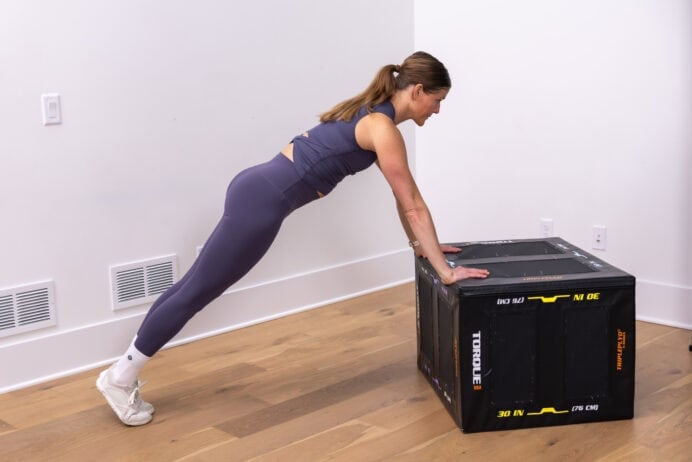
30-Minute HIIT Circuit
Build muscle, break a sweat and improve heart health with this 30-minute HIIT workout at home. 12 full-body exercises are stacked together in an effective time-drop format: building strength in the entire body while improving cardiovascular conditioning and endurance.
I’m a huge advocate of strength training, but I also think HIIT exercises are a necessary part of any well-rounded workout routine.
Although HIIT is well-known for benefits like burning calories, fat loss and weight loss, I like to think of HIIT as strength training for my heart. Just like lifting weights challenges and strengthens your muscles, HIIT challenges and strengthens your cardiovascular system.
High-intensity intervals push your heart rate close to its max, forcing your cardiovascular system to pump more blood and oxygen. These bursts of all-out effort are followed by brief recovery periods, allowing your heart to slow down and relax. This repeated “contract and relax” cycle is like doing reps for your heart muscle, making it stronger, more efficient at pumping blood and better at recovering quickly.
STAY HYDRATED
My Favorite Electrolytes
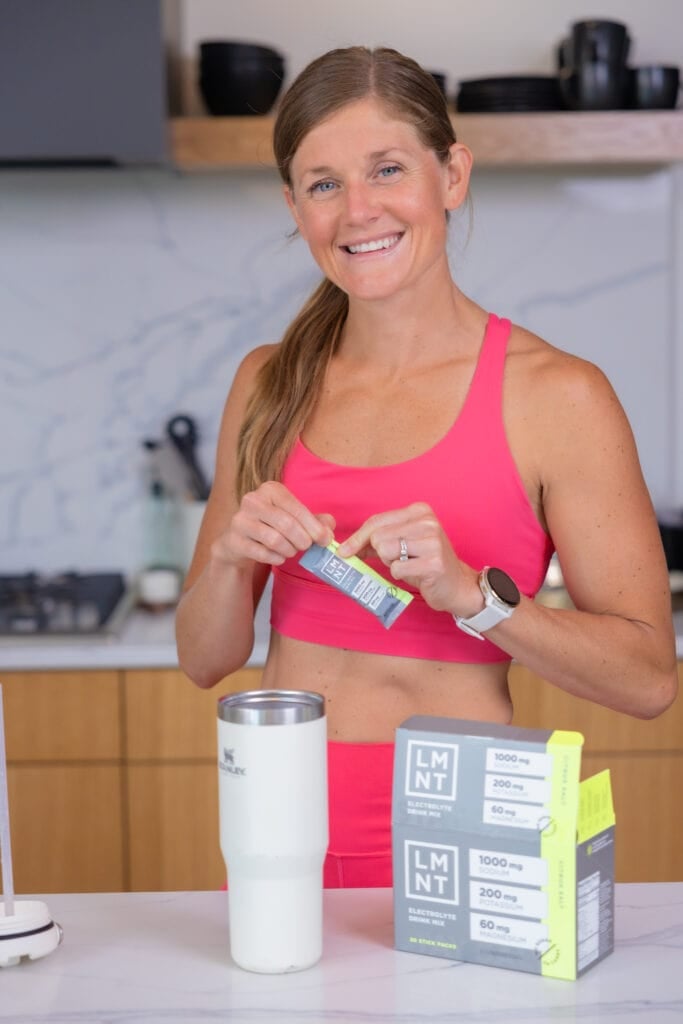
Today’s functional circuit training HIIT workout combines 12 effective exercises in a fun and engaging time-drop format. I personally love time-drop workouts because the work periods are scaled to match the intensity of the exercise – meaning you’ll perform the strength exercises for longer, followed by short bursts of all-out HIIT.
Today’s dumbbell HIIT workout is incredibly efficient because it combines high-intensity dumbbell strength training with power plyometrics and HIIT exercises. This allows you to get the benefits of multiple different types of training in one workout:
- Strength (40 seconds): improves muscle strength and definition.
- Power (30 seconds): improves bone density, athleticism, speed and reaction time.
- HIIT (20 seconds): improves cardiovascular conditioning and heart health.
This well-rounded, high-intensity workout is ideal for hybrid athletes, busy parents and anyone who wants to improve overall fitness levels or lose weight at home. You’ll hit the upper body, lower body, core and get your heart pumping – all using just a set of dumbbells.
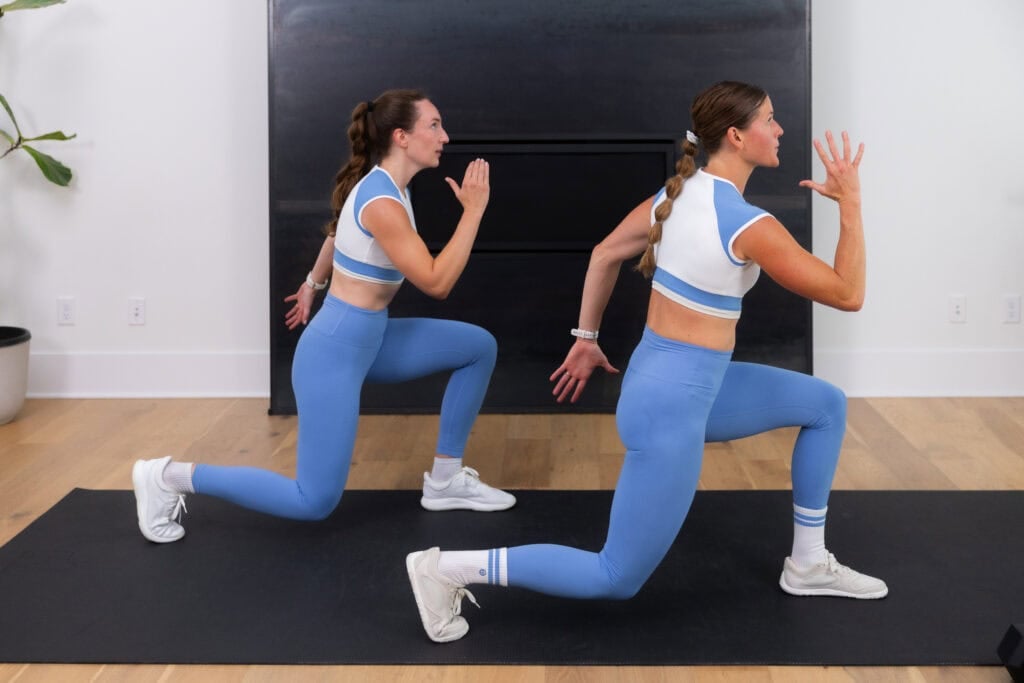
Read A 5-Star Review ⭐⭐⭐⭐⭐
“Loved this one so much! The combo of strength and HIIT was a true challenge that left me feeling proud to complete it. I pushed myself with heavy weights, knowing the intervals dropped. Bookmarking this one!”
— Christie K.
Workout Details
This circuit workout combines 12 of the best full-body cardio HIIT exercises you can do at home with minimal equipment. Modifications are provided for both beginners and advanced athletes to scale the workout to meet your needs.
I recommend adding HIIT workouts like this one to your training program 1-2 times a week to improve endurance, speed, agility and cardiovascular conditioning. If you’re interested in a 2-week HIIT program, try my HIITStrong Workout Plan.
Workout Equipment
Medium to Heavy Set of Dumbbells. I recommend between 5-25 lbs, depending on your fitness level. I’m using 15-25 lb dumbbells in today’s cardio HIIT workout.
Workout Instructions
Follow along with the guided 30-Minute At-Home HIIT Workout on YouTube, led by me — your certified personal trainer, Lindsey Bomgren.
Your Workout Looks Like This:
- Guided Warm-Up and Cool-Down
- 4 HIIT Circuits
- 3 Exercises Per Circuit (1 strength exercise, 1 power exercise and 1 HIIT exercise)
- Time Drop Intervals (40/10, 30/10, 20/10. The work time decreases as the exercise intensity increases; rest time always remains 10 seconds. Perform as many reps as possible while maintaining proper form during the timed intervals.)
- Repeat all 12 HIIT circuit exercises x3 sets
Note: Today’s workout is an updated version of a popular HIIT circuit workout. I re-filmed this workout to improve the audio and video quality and share some new moves. If you try both, I’d love to know which version is your favorite!
Workout Outline
CIRCUIT ONE:
CIRCUIT TWO:
CIRCUIT THREE:
CIRCUIT FOUR:
1. Squats
Targets: Lower body – glutes, quadriceps, hamstrings, hips and core.
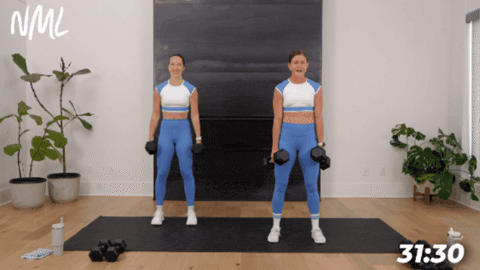
How to Do a Squat
- Start standing feet shoulder-width apart and knees slightly bent, holding a pair of dumbbells at your sides.
- Lower down into a squat position, lowering your hips down parallel with your knees. Drive your knees out toward your outer toes.
- Drive through your heels to stand tall, returning to a standing position.
2. Squat and Calf Raise
Targets: Legs, glutes, quadriceps (thighs), hamstrings, calves and core.
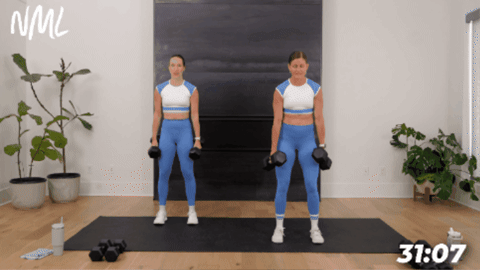
How to Do a Squat and Calf Raise
- Start standing feet shoulder-width distance apart, knees slightly bent, core engaged. Hold 1 dumbbell in each hand outside your thighs.
- Lower down into a squat position, lowering your hips down parallel with your knees. Drive your knees out toward your outer three toes.
- Then, squeeze your glutes as you drive through your heels to stand tall.
- As you stand, perform a calf raise by lifting your heels off the ground.
- With control, lower your heels to the ground, returning to the starting position.
3. Squat Jumps
Targets: Glutes, quads, hamstrings, calves and core.
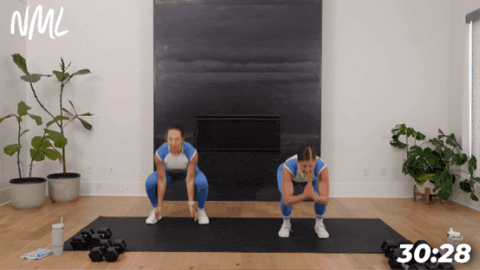
How to Do a Squat Jump
- Start standing with feet shoulder-width apart, knees slightly bent and arms at your sides.
- Lower down into a squat position, bringing your hips back and down until they’re about parallel with your knees. Keep your chest lifted and core engaged.
- Drive through your heels to explode upward into a jump, swinging your arms up for momentum.
- Land softly back into a squat position, knees bent to absorb impact.
Modification: Option to reduce the impact of this exercise by skipping the jump and rising onto your toes instead.
4. Back Row
Targets: Latissimus dorsi (or lats; the largest back muscle known for its large, flat “V” shape)
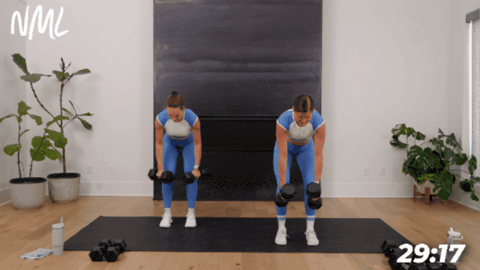
How to Do a Dumbbell Back Row
- Stand with your feet slightly wider than shoulder-width apart, knees slightly bent. Grip a set of dumbbells, palms facing in towards each other.
- Hinge forward at the hips until your body is in a straight line, neck in line with your spine, flat back, and belly button pulled back towards your spine.
- As you pull the weights back towards your hips in a rowing movement, squeeze your shoulder blades together. Stop when your elbows are in line with your hips.
- With control, slowly lower the dumbbells back down to the starting position. Think up on a one-count, down slow and controlled on a two-count.
5. Back Row, Clean and Press
Targets: Legs, glutes, hamstrings, quads, hips, back, shoulders, abs and core.
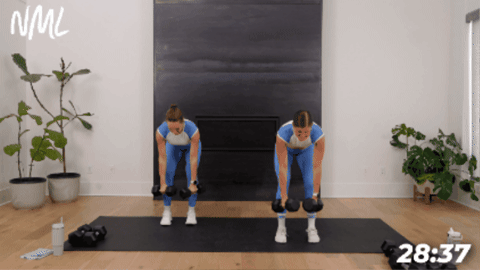
How to Do a Back Row, Clean and Overhead Press
- Start standing, feet shoulder-width apart, knees slightly bent. Hold a set of dumbbells at your sides, palms facing in towards each other.
- Hinge forward at the hips until your body is in a straight line, neck in line with your spine, flat back, and belly button pulled back towards your spine.
- Squeeze your back to pull your elbows towards your hips, performing a dumbbell row. Then, with control, lower the dumbbells to starting position.
- Then, press through your heels to stand tall. As you stand, clean the dumbbell ups, catching them at shoulder height.
- Press the weights straight overhead, wrists stacked over shoulders and elbows staying narrow near your ears.
- Slowly and with control, lower the weights, returning to the starting position.
6. Press Jack
Targets: Arms, shoulders, back, chest, biceps, triceps, abs, core and calves.
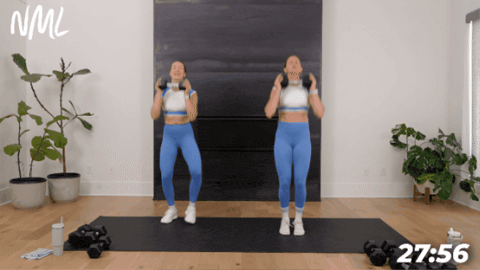
How to Do a Press Jack
- Start standing, feet hip-width apart, knees bent, core engaged. Hold one dumbbell horizontally at your chest. Tuck your tailbone to engage your core.
- Then, “jack” your feet out wider than your shoulders (as if you are performing jumping jacks) as you press your arms straight overhead, locking out your biceps by your ears.
- “Jack” the feet back in as you lower the weight to your chest, returning to the starting position.
Modification: Keep it low impact by alternating toe tap outs versus “jacking” your feet.
7. Deadlift
Targets: The posterior chain or backside of the body. Specifically targeting the hamstrings, glutes, hips, calves, lower back and core.
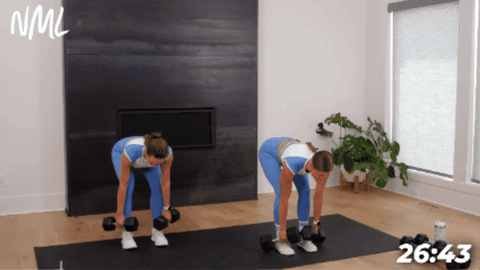
How to Do a Romanian Deadlift (RDL)
- Start standing feet shoulder-width apart and knees slightly bent. Hold a dumbbell in each hand at your thighs (overhand grip, palms face your body).
- Hinge forward at the hips, pushing your hips back as you lower the dumbbells down along the front of your body. You should feel a stretch in the back of your legs (hamstrings). Focus on keeping your back in neutral alignment with your neck and shoulders throughout the entire movement (straight line from head to tailbone). Keep a slight bend in your knees to avoid ‘locking out’ the joint.
- Then, drive through your heels, squeezing your glutes as you drive your hips forward to return to standing.
8. Deadlift, Clean and Reverse Lunge
Targets: Legs, glutes, quads, hamstrings, hip flexors, lower back and core.
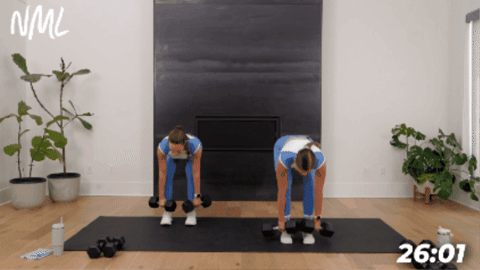
How to Do a Deadlift, Clean and Reverse Lunge
- Start standing feet hip-distance apart, holding a dumbbell in each hand at your sides, palms facing your body.
- Hinge forward at the hips, pushing your hips back as you lower the dumbbells down along the front of your body.
- Press through your heels to stand tall, driving the dumbbells up and catching them at your shoulders as you stand.
- Step your right leg back into a reverse lunge position.
- Hold this lunge position as you drop your back right knee towards the ground. Lowering your hips until both knees reach a 90-degree angle, front left thigh parallel to the floor. Shoulders remain stacked over hips throughout the entire exercise.
- Press into your front left heel, squeezing your glutes to stand tall and return to the starting position.
Modification: If lunges hurt your knees, substitute one of these lunge alternatives.
9. Lunge Jump
Targets: Legs, hamstrings, quads, glutes, abs and core.
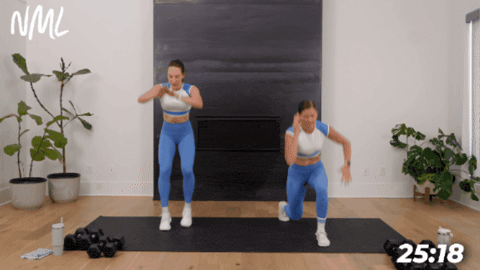
How to Do Lunge Jumps
- Stand with your feet slightly wider than shoulder-width apart, knees slightly bent.
- Step your right leg back into a reverse lunge, lowering your hips until both knees reach a 90-degree angle, front thigh parallel to the floor.
- Then perform a “lunge jump” by exploding up from your reverse lunge position. Switch your legs by landing softly in a reverse lunge with the left leg back, right leg forward.
- Perform a lunge jump again, exploding up from your reverse lunge position, this time landing softly in a reverse lunge with the right leg back, left leg forward.
Modification: Perform knee slams instead of jump lunges.
10. Skull Crusher
Targets: All three heads of the tricep muscle (lateral head, medial head, and long head).
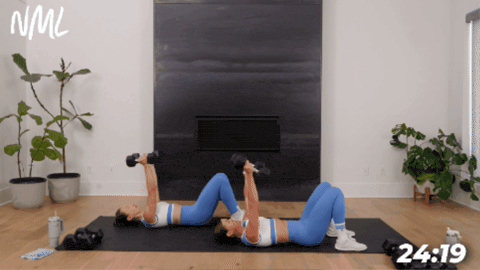
How to Do a Skull Crusher
- Lie flat on the ground or on a bench or stability ball; knees bent and feet flat on the floor.
- Hold a dumbbell in each hand and extend your arms, dumbbells stacked over shoulders.
- Bending at the elbows, slowly lower the dumbbells towards your head (just bending at the elbows, lowering the dumbbells towards your temples).
- Pause at the bottom, then squeeze through the back of your arms to straighten your elbows, press the dumbbells back overhead and return to the starting position.
11. Chest Fly and Knee Tuck
Targets: The chest (pectoralis major and pectoralis minor), triceps, upper abs, lower abs, obliques, transverse abdomen and hip flexors.
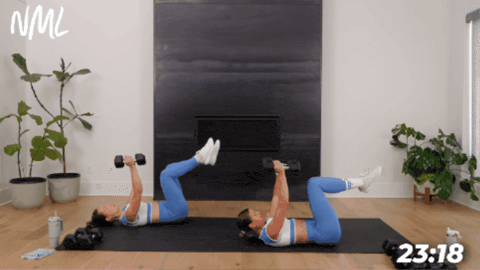
How to Do a Chest Fly and Knee Tuck
- Lie on your back, knees bent at 90 degrees and stacked over your hips. Hold one dumbbell in each hand, palms facing in towards each other, and arms extended above your shoulders.
- Inhale to brace your core, pressing your lower back into the mat as you slowly open your arms (slight bend in the elbows), lowering the dumbbells in a wide arc until they reach shoulder level (or the ground). Your elbows should remain soft and not overextended. As you perform the chest fly, simultaneously straighten your legs, kicking your heels out away from your body. The lower your heels, the more difficult this exercise will be.
- Exhale as you pull the dumbbells back to the starting position, squeezing your chest muscles together. As you pull the dumbbells back, simultaneously pull your knees in, performing a knee tuck.
Modification: Option to omit the leg extension, keeping the knees tucked in at 90 degrees as you perform the chest fly.
12. Burpee
Targets: Total body — legs, hip flexors, calves, arms, shoulders, back, abs and core.
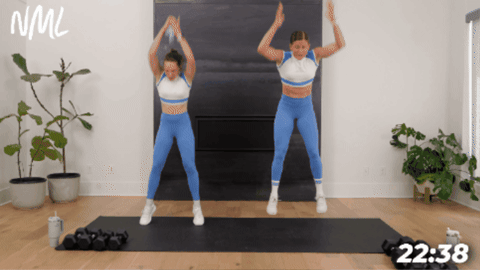
How to Do a Burpee
- Stand with feet hip-distance apart or a little wider.
- Engage your core and lower your hips down to the bottom of a squat as you plant your hands on the ground in front of your toes.
- Step or jump both feet back to a high plank position. Make a straight line with your body from head to feet.
- Bend your elbows to lower your chest to the ground, then press up, performing a push-up.
- Jump both feet forward, landing softly in a deep squat with feet outside your hands.
- Press through your heels to drive up, jumping into the air.
Modification: Option to sub towel slams. Or, make the dumbbell burpee low impact by stepping back to plank and walking your feet back into the bottom of the low squat instead of jumping back and jumping in.
FAQs
The 30-20-10 rule is a method of structuring a 60-second HIIT interval. You perform an exercise at an easy pace for 30 seconds, moderate pace for 20 seconds and an all-out sprint for 10 seconds. This is similar to the time-drop format found in today’s workout.
I don’t recommend performing a high-intensity interval training workout every single day. Although it has many health benefits when used in moderation, HIIT can also be a stressor on your body when performed too often or for too long. Instead, I recommend incorporating bodyweight HIIT workouts 1-2x per week alongside strength training workouts, abs workouts and mobility/recovery workouts as part of a well-rounded workout plan.
HIIT workouts tend to be quick, efficient and require just your bodyweight or minimal equipment, making them accessible to fitness beginners. That said, HIIT workouts are demanding, and 30 minutes may be too long for a beginner. Instead, I recommend starting with a 15-Minute Beginner HIIT Workout to increase your baseline fitness and learn proper form before increasing the intensity.
More Workouts
HIITPin This At-Home HIIT Workout
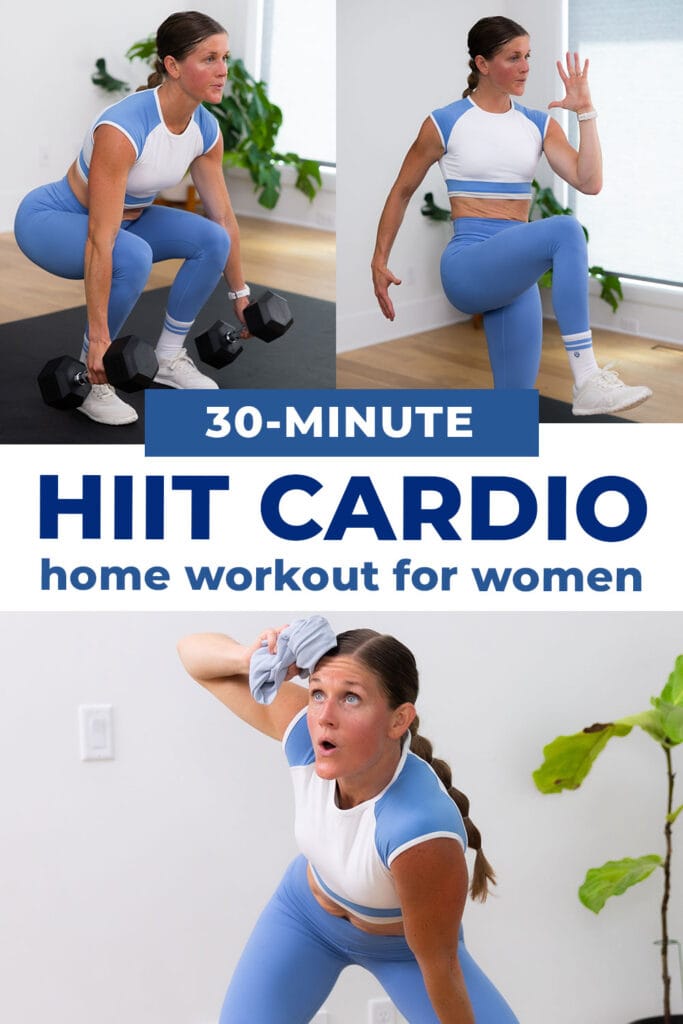










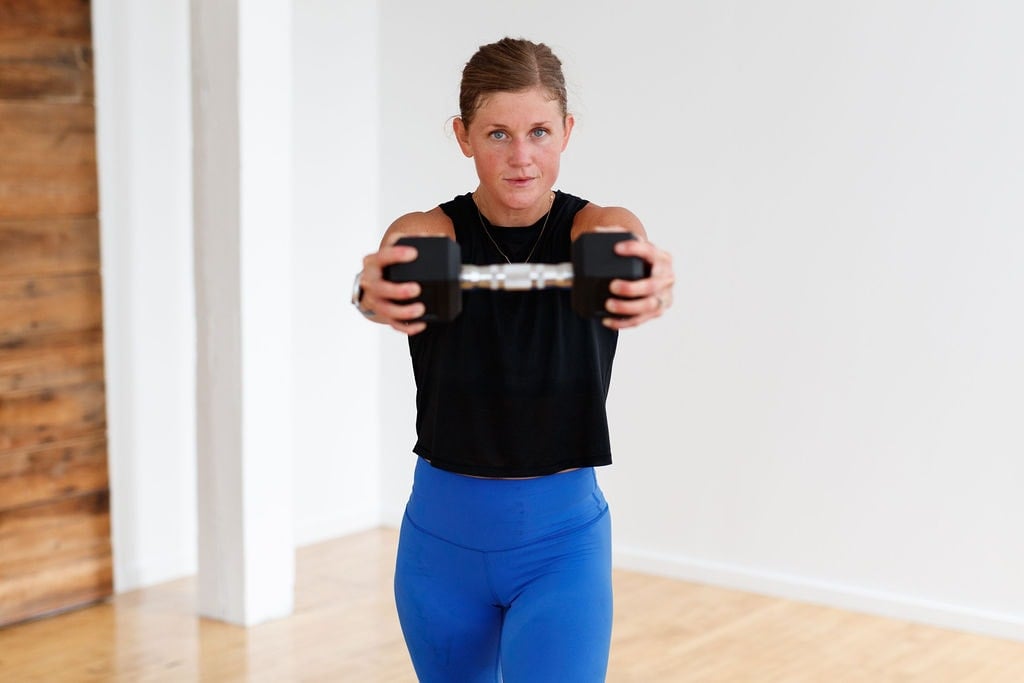

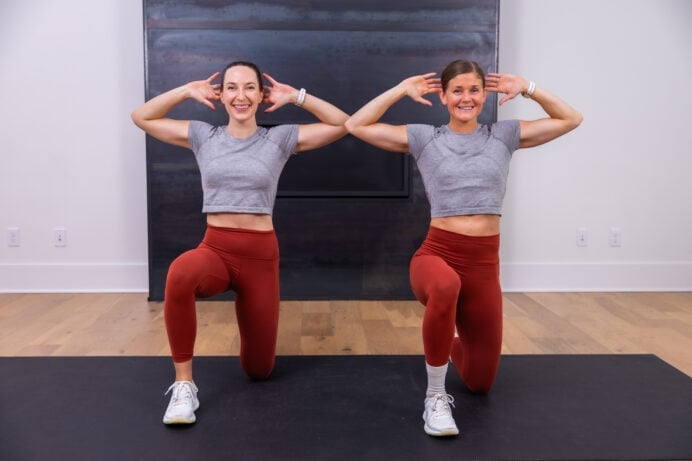
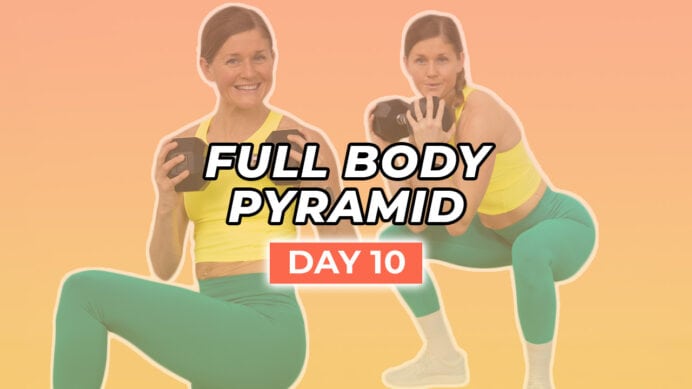
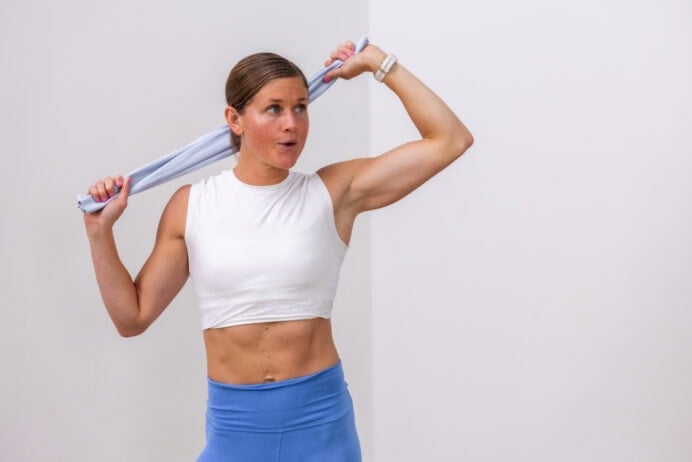

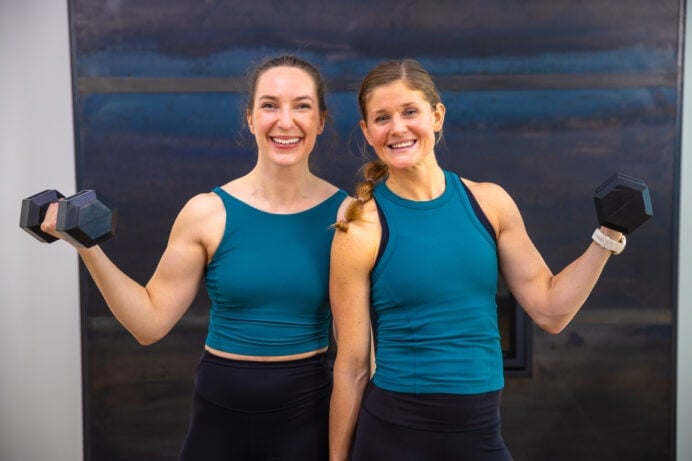
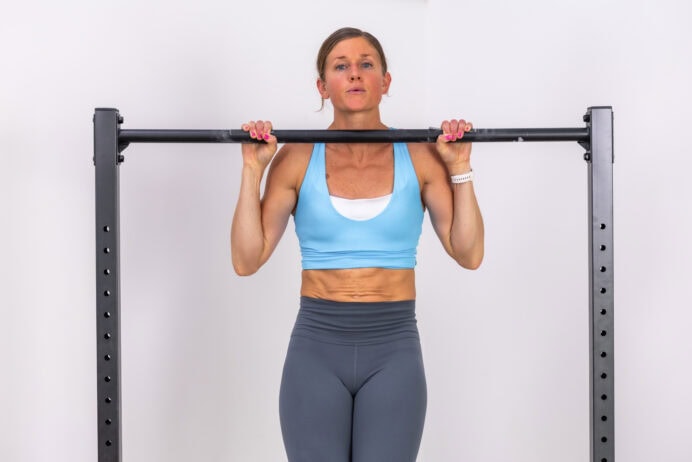
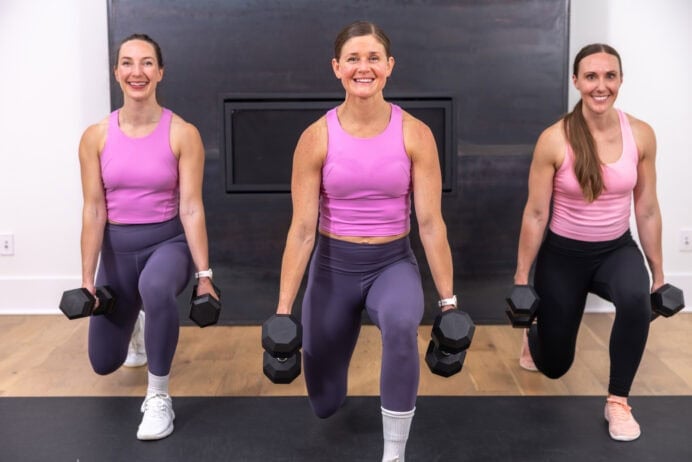
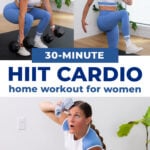
Hi Lindsey,
My name is Tara and I am 41. I have two teenage daughters (13 & 17 yr old) and I strongly believe it’s so important to set a healthy example for them. I have been working out ‘with you’ and NML for just over a year now. I have wanted to comment for awhile and just never got the chance so I am finally taking the time to say THANK YOU! My husband has commented several times that he is impressed with how toned I am and my 17 yr old told me I had a “good butt shape” the other day! Which totally made me giggle! Thank you for the great workouts and continuing to set a positive, healthy example for all of us who sweat along with you!
Sincerely,
Tara
Hi Tara! I’m so glad you’re loving the workouts — thank you for taking the time to say Thank You! I love that you are feeling strong and toned AND setting an awesome example for your daughters! Keep up the great work! -Lindsey